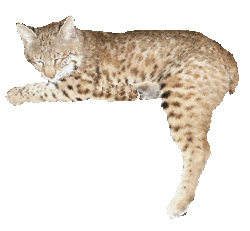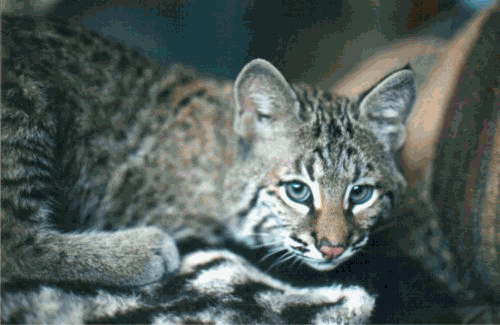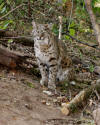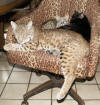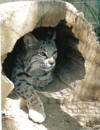Lynx
rufus-Bobcat.This native feline ranges in size from about 15 to 40 pounds.
Found throughout the county, there are wide
variations in body conformation and coat patterns.
Some are beautifully spotted, some are plain,
northern bobcats have longer fur throughout the
year, southern bobcats seem to be longer legged and
lankier, and can have stunning rosettes and spots.
Bobcats are
certainly not for everybody. In fact they are only
right for a special few. But when the right person
hand-raises a baby bobcat in the right environment,
they will experience the intense affection, and
powerful bobcat personality, that will provide many
years of wonder and joy.
Bobcats are
an important ambassador species for wildlife
educators. When baby bobcats are exposed to lots of
environmental stimulus and people, they develop
outgoing and confident, friendly, personalities.
According to the USDA policy, bobcats, like all
other carnivores, cannot be declawed, so outreach
educators need to habituate their young bobcats to
regular nail clipping to reduce the risk of injury.
Adult Bobcats tend to loose their interest in
traveling so most outreach education program bobcats
only have a working life of about 2 to 4 years.
After that, this species usually prefer to stay home
in their familiar enclosure.
Bobcats are
predators armed with sharp teeth and claws. This
makes them unsuitable to be around small children
who cannot be trusted to show good judgment
reliably. Couples with young family members, or
contemplating starting a family, need to pass on
purchasing a bobcat.
Additionally,
being a native species, many state Game and Fish or
Natural Resource Departments require permits to
possess this species.. When people want to raise
bobcats as companion animals, it is counter to the
agency's hunting mindset that they are wild animals
to be harvested, and not to be cherished as loving
companions. Some states only permit licensed
educators or zoos to possess bobcats. For those
interested in bobcats as a companion, you must live
in a state that permits this kind of ownership.
Bobcat
kittens are hand reared starting at about 14 days.
They will nurse a bottle until eight weeks to twelve
weeks of age. Bottle feeding is a psychologically
important activity for these felines. The milk
formula should be a quality product like KMR or Milk
Matrix 33/40 with additional calcium and vitamins.
When the kitten reaches 5 to 6 weeks, begin adding
Iams Kitten formula canned meat diet to the milk
mixture.
Kittens
raised with dogs or puppies or domestic cats can
develop friendships with them. Bobcats generally do
well in the house, aside from climbing on the
kitchen counters and cabinets, racing across the
furniture, or playing in the toilet. Kittens will
use a litter box naturally and hardly ever miss
until they reach sexual maturity, at which time
their toilet habits change.
It is very
important to spay or neuter your pet before it
reaches adulthood if you wish to continue to allow
it access to your home.
Adult bobcats
benefit from a large outside enclosure. Build an
enclosure of at least 600 square feet so that they
have plenty of room to run and play, and you have
space to visit them in. Feed weaned bobcats canned
Zupreem, Mazuri dry or a raw meat diets with calcium
and vitamins added. The calcium/phosphorus ratio
must be at least 1.2 to 1. Boneless meats are
especially unbalanced without calcium
supplementation. Chicken necks provide a rich source
of calcium and are a good item to feed in addition
to boneless meat sources like chunk beef, or liver
and kidney.
 From
Our Jungle toYours
From
Our Jungle toYours



![]()
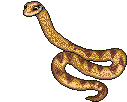
![]()
